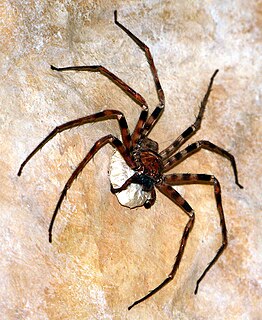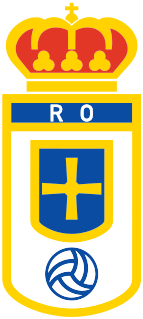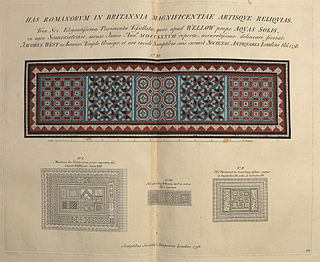
My Man Jeeves is a collection of short stories by P. G. Wodehouse, first published in the United Kingdom in May 1919 by George Newnes. Of the eight stories in the collection, half feature the popular characters Jeeves and Bertie Wooster, while the others concern Reggie Pepper, an early prototype for Bertie Wooster.
Blut Aus Nord is a French black metal band from Mondeville, Calvados, France, which has incorporated avant-garde elements in its music.

Gasteracantha is a genus of orb-weaver spiders first named by Carl Jakob Sundevall in 1833. The females of most species are brightly colored with six prominent spines on their broad, hardened, shell-like abdomens. The name Gasteracantha is derived from the Greek gaster (γαστήρ), meaning "belly, abdomen", and akantha (άκανθα), meaning "thorn, spine". Spiny-backed orb-weavers are sometimes colloquially called "crab spiders" because of their shape, but they are not closely related to the true crab spiders. Other colloquial names for certain species include thorn spider, star spider, kite spider, or jewel spider.

Heteropoda is a genus of spiders in the family Sparassidae, the huntsman spiders. They are mainly distributed in tropical Asia and Australia, while at least one species, H. venatoria, has a cosmopolitan distribution, and H. variegata occurs in the Mediterranean.

Anaxita is a genus of moths in the family Erebidae. The genus was erected by Francis Walker in 1855.

Konzhukovia is an amphibian genus that belongs to an extinct group of temnospondyls, the largest clade of basal tetrapods including about 198 genera, 292 species, and more than half of which were alive during the early Mesozoic period. The animal was a predator that lived about 260 million years ago, and could get up to about 3 meters in length. Specifically, Konzukovia lived during the Permian, between 252 and 270 million years ago according to the type of rock the fossil was found in. There are three species within this genus, K. vetusta, K. tarda, and K. sangabrielensis, the first two originating from Russia while the latest originating from Southern Brazil. The discovery of this specimen in Southern Brazil provided more evidence to support the idea that during this animals existence, there was a “biological corridor” because of the supercontinent Pangea, allowing these species to be found so far apart from each other. Konzhukovia belongs to the family Archegosauridae, a family consisted of large temnospondyls that most likely compare to modern day crocodiles. Since the discovery of the latest species, K. sangabrielensis Pacheco proposes that there must be the creation of a new family, Konzhokoviidae, a monophyletic group in a sister-group relationship with Stereospondlyi in order to accommodate the three species. Konzhukovia skulls usually exhibit typical rhinesuchid features including an overall parabolic shape, small orbits located more posteriorly, and the pterygoids do not reach the vomer. These animals were long-snouted amphibians that had clear adaptations made for fish catching, as well as exemplifying aquatic features.
The 1990–91 Segunda División B season was the 14th since its establishment. The first matches of the season were played on 1 September 1990, and the season ended in 23 June 1991 with the promotion play-off final games.

Real Oviedo "B", also known but not officially as Real Oviedo Vetusta, is a Spanish football team based in Oviedo, in the autonomous community of Asturias. Founded in 1940 as Sociedad Deportiva Vetusta it is the reserve team of Real Oviedo, and currently plays in Segunda División B – Group 1, holding home games at El Requexón, with a 3,000-seat capacity.
The King Alfonso XIII's Cup 1925 was the 25th staging of the Copa del Rey, the Spanish football cup competition.

Agrotis vetusta, the old man dart, spotted-legged cutworm or muted dart is a moth of the family Noctuidae. The species was first described by Francis Walker in 1865. It is found in North America, from southern Alaska to Nova Scotia, southward into Mexico.

Anaxita decorata, the decorated beauty, is a moth of the family Erebidae. It is found in Mexico and Central America.

Vetusta Monumenta is the title of a published series of illustrated antiquarian papers on ancient buildings, sites, and artefacts, mostly those of Britain, published at irregular intervals between 1718 and 1906 by the Society of Antiquaries of London. The folio sized papers, usually written by members of the society, were first published individually, and then later in collected volumes.
A. elegantissima may refer to:
Anaxita drucei is a moth of the family Erebidae. It is found in Guatemala.
Anaxita martha is a moth of the family Erebidae. It is found in Peru.
Anaxita sannionis is a moth of the family Erebidae. It is found in Peru.
Anaxita sophia is a moth of the family Erebidae. It is found in Venezuela.

Phiala is a genus of moths in the family Eupterotidae.
Vetusta Morla is the spanish indie-rock band, originally from the city of Tres Cantos, located near Madrid, Spain. The band had been formed in 1998 and took its name by the giant old turtle called Morla, character of the children's book "The Neverending Story", written by german writer Michael Ende. "Vetusta" means "old" or "decrepit" in Spanish.








